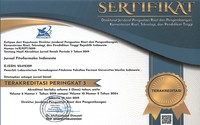KAJIAN KOMPOSISI KIMIA, NILAI NUTRISI, DAN ETNOFARMAKOLOGIS TANAMAN GENUS KENARI
Abstract
Full Text:
PDFReferences
Arenas, E.H. & Trinidad, T.P., 2017a, ‘Fate of polyphenols in pili (Canarium ovatum Engl.) pomace after in vitro simulated digestion’, Asian Pac J Trop Biomed. 7, 53–58.
Arenas, E.H. & Trinidad, T.P., 2017b, ‘Acute effects of thermally processed pili (Canarium ovatum, Engl.) pomace drink on plasma antioxidant and polyphenol status in humans’, Avicenna J Phytomed. 7, 467-476
Aril-dela Cruz, J.V., Bungihan, M.E., dela Cruz, T.E.E. & Sagum, R.S., 2018, ‘Canarium ovatum Engl. (Pili) exocarp crude extract as functional food colorant incorporated in yogurt developed product’, Food Research. 2, 89-98.
Azlan, A., Prasad, K.N., Khoo, H.E., Abdul-Aziz, N., Mohamad, A., Ismail, A. & Amom, Z., 2010, ‘Comparison of fatty acids, vitamin E and physicochemical properties of Canarium odontophyllum Miq. (dabai), olive and palm oils’, J. Food Compos. Anal. 23, 772–776.
Bai, S.H., Darby, I., Nevenimo, T., Hannet, G., Hannet, D., Poienou, M., Grant, E., Brooks, P., Walton, D., Randall, B. & Wallace, H.M., 2017,
‘Effects of roasting on kernel peroxide value, free fatty acid, fatty acid composition and crude protein content’, Plos One. Doi: 10.1371/journal.pone.0184279.
Bandaranayake, W.M., 1980, ‘Terpenoids of Canarium zeylanicum’, Phytochemistry. 19, 255-257.
Basri, D.F. & Sandra, V., 2016, ‘Synergistic interaction of methanol extract from Canarium odontophyllum Miq. leaf in combination with oxacillin against Methicillin-Resistant Staphylococcus aureus (MRSA) ATCC 33591’, Int J Microbiol. Doi: 10.1155/2016/5249534.
Betts, M.J. & Russell, R.B., 2003, ‘Amino acid properties and consequences of substitutions’, in Michael R. Barnes & Ian C. Gray, Bioinformatics for Geneticists. pp, 289-314, John Wiley & Sons, Ltd., New Jersey.
Boorsma, W.G., 1914, ‘ The kernels of Canarium commune as an addition to milk in infant feeding’, https://pdfs.semanticscholar.org/.../a704034fbc8a8e648090e, diakses pada 14 Februari 2018.
Bruckner, G., 2008, ‘Fatty acids and cardiovascular disease’, in Chow C.K, Fatty Acids in Foods and Their Health Implication. pp. 1069, CRC Press, Boca Raton.
Chew, L.Y., Prasad, K.N., Amin, I., Azrina, A. & Lau, C.Y., 2011, ‘Nutritional composition and antioxidant properties of Canarium odontophyllum Miq. (dabai) fruits’, J. Food Compos. Anal. 24, 670–677.
Chua, H.P., Nicholas, D. & Yahya, M.N.A., 2015, ‘Physical properties and nutritional values of dabai fruit (Canarium odontophyllum) of different genotypes’, J. Trop. Agric. and Fd. Sc. 43, 1-10.
Djarkasi, G.S.S., Nurali, E.J.N., Sumual, M.F. & Lalujan, L.E., 2011, ‘Analysis of bioactive compound in canarium nut (Canarium indicum L), Research Final Report, Tropical Plant Curriculum Project in cooperation with USAID–Texas A&M University, Sam Ratulangi University.
Dubois, V., Breton, S., Linder, M., Fanni, J. & Parmentier, M., 2007, ‘Fatty acid profile of 80 vegetable oils with regard to their nutritional potential’, Eur J Lipid Sci Technol. 109, 710-732.
Dzotam, J.K., Touani, F.K. & Kuete, V., 2016, ‘Antibacterial activities of the methanol extracts of Canarium schweinfurthii and four other Cameroonian dietary plants against multi-drug resistant Gram-negative bacteria’, Saudi J Biol Sci. 23, 565–570.
Evans, B., 1994, ‘Overview of Resource Potential for Indigenous Nut Production in the South Pacific’, in M. L. Stevens, R. M. Bourke & B. R. Evans (eds.), South Pacific Indigenous Nuts Proceedings, Le Lagon Resort, Port Vila, Vanuatu, October 31-November 4, 1994, pp. 11.
He, Z. & Xia, W., 2007a, ‘Nutritional composition of the kernels from Canarium album L.’, Food Chem. 102, 808-811.
He, Z. & Xia, W., 2007b, ‘Analysis of phenolic compounds in Chinese olive (Canarium album L.) fruit by RPHPLC–DAD–ESI–MS’, Food Chem. 105, 1307-1311.
Heyne, K., 1987, Tumbuhan Berguna Indonesia, Yayasan Sarana Wana Jaya, Jakarta.
Ito, M., Shimura, H., Watanabe, N., Tamai, M., Harada, K., Takahashi, A., Tanaka, Y., Arai, I., Pei-ling, Z., Chang, R., Wei-ming, C., Jun-shan, Y., Ya-lun, S. & Yu-lan, W., 1990, ‘Hepatoprotective compounds from Canarium album and Euphorbia nematocypha’, Chem. Pharm. Bull. 38, 2201-2203.
Kakuda, Y., Jahaniaval, F., Marcone, M.F., Montevirgen, L., Montevirgen, Q. & Umali, J., 2000, ‘Characterization of pili nut (Canarium ovatum) oil: Fatty acid and triacylglycerol composition and physicochemical properties’, J Am Oil Chem Soc. 77, 991–997.
Kamtchouing, P., Kahpui, S.M., Dzeufiet, P.D.D., T´edong, L., Asongalem, E.A., Dimo, T., 2006, ‘Anti-diabetic activity of methanol/methylene chloride stem bark extracts of Terminalia superba and Canarium schweinfurthii on streptozotocin-induced diabetic rats’, J Ethnopharmacol. 104, 306–309.
Khoo, H.E., Azlan, A., Ismail, A., Abas, F. & Hamid, M., 2014, ‘Inhibition of oxidative stress and lipid peroxidation by anthocyanins from defatted Canarium odontophyllum pericarp and peel using in vitro bioassays’, Plos One. Doi:10.1371/journal.pone.0081447.
Koudou, J., Abena, A.A., Ngaissona, P. & Bessie`re, J.M., 2005, ‘Chemical composition and pharmacological activity of essential oil of Canarium schweinfurthii’, Fitoterapia. 76, 700–703.
Kuete, V., Sandjo, L.P., Mbaveng, A.T., Seukep, J.A., Ngadjui, B.T. & Efferth, T., 2015, ‘Cytotoxicity of selected Cameroonian medicinal plants and Nauclea pobeguiniitowards multi-factorial drug-resistant cancer cells’, BMC Complement Altern Med. Doi: 10.1186/s12906-015-0841-y.
Kuo, CT., Liu, TH., Hsu, TH., Lin, FY. & Chen, HY., 2015, ‘Antioxidant and antiglycation properties of different solvent extracts from Chinese olive (Canarium album L.) fruit’, Asian Pac J Trop Med. 8, 1013–1021.
Leakey, R., Fuller, S., Treloar, T., Stevenson, L., Hunter, D., Nevenimo, T., Binifa, J. & Moxon, J., 2008, ‘Characterization of tree-to-tree variation in morphological, nutritional and medicinal properties of Canarium indicum nuts’, Agroforest Syst. 73, 77-87.
Lim, T.K., 2012, Edible Medicinal and Non-Medicinal Plants, Springer, Netherlands.
Lv, Z., Chen, K., Zeng, Y. & Peng, Y., 2011, ‘Nutritional composition of Canarium pimela L. kernels’, Food Chem. 125, 692–695.
Massimo, C., Lucio, T., Jesus, M.A., Giovanni, L. & Gluseppe, C., 2009, ‘Extra virgin olive oil and oleic acid’, Nutricion Clinica Dietetica Hospitalaria. 29, 12-24.
Millena, C.G. & Sagum, R.S., 2018, ‘Philippine Pili (Canarium ovatum, Engl.) varieties as source of essential minerals and trace elements in human nutrition’, J Food Compos Anal. 69, 53–61.
Mogana, R. & Wiart, C., 2011a, ‘Canarium L.: A phytochemical and pharmacological review, J. Pharm Res. 4, 2482-2489.
Mogana, R., Teng-Jin, K. & Wiart, C., 2011b, ‘In vitro antimicrobial, antioxidant activities and phytochemical analysis of Canarium patentinervium Miq. from Malaysia, Biotechnol Res Int. Doi:10.4061/2011/768673.
Mogana, R., Teng-Jin, K. & Wiart, C., 2013a, ‘Anti-inflammatory, anticholinesterase, and antioxidant potential of scopoletin isolated from Canarium patentinervium Miq. (Burseraceae Kunth)’, Evid-Based Complement. Altern. Med. Doi: 10.1155/2013/734824.
Mogana, R., Teng-Jin, K. & Wiart, C., 2013b, ‘The medicinal timber Canarium patentinervium Miq. (Burseraceae Kunth.) is an anti-inflammatory bioresource of dual inhibitors of cyclooxygenase (COX) and 5-lipoxygenase (5-LOX), ISRN Biotechnol. Doi: 10.5402/2013/986361.
Mogana, R., Adhikari, A., Debnath, S., Hazra, S., Hazra, B., Teng-Jin, K. & Wiart, C., 2014, ‘The antiacetylcholinesterase and antileishmanial activities of Canarium patentinervium Miq.’ BioMed Res Int. Doi: 10.1155/2014/903529.
Osborn, H.T. &Akoh, C .C., 2002, ‘Structured lipids-novel fats with medical, nutraceutical, and food applications’, Compr Rev Food Sci F Safety. 3, 110-120.
Pham, L.J. & Dumandan, N.G., 2015, ‘Philippine Pili: Composition of the lipid molecular species’, J Ethn Foods. 2, 147-153.
Prasad, K.N., Chew, L.Y., Khoo, H.E., Kong, K.W., Azlan, A. & Ismail, A., 2010, ‘Antioxidant capacities of peel, pulp, and seed fractions of Canarium odontophyllum Miq. fruit’, J Biomed Biotechnol. Doi:10.1155/2010/871379.
Prasad, K.N., Chew, L.Y., Khoo, H.E., Yang, B., Azlan, A. & Ismail, A., 2011, ‘Carotenoids and antioxidant capacities from Canarium odontophyllum Miq. fruit’, Food Chem. 124, 1549-1555.
Rahman, H., Tursino, Sitompul, J.P., Anggadiredja, K. & Gusdinar, T., 2015, ‘The nutritional fatty acids profile and physicochemical properties of Canarium indicum nut oil’, Int J Pharmacogn Phytochem Res. 7, 1222-1226.
Rahman, H., Sitompul, J.P., Anggadiredja, K., Lee, H.W. & Gusdinar, T., 2016, ‘The stereospecific analysis of Canarium indicum oil-fatty acid based in triglycerides using high-performance liquid chromatography’, Int J Pharm Clin Res. 8 (Suppl), 403-406.
Saari, S.M., Basri, D.F., Budin, S.B., Abd Warif, N.M., 2017, ‘Effects of Canarium odontophyllum leaves on plasma glucose and T lymphocyte population in streptozotocin-induced diabetic rats’, Saudi J Biol Sci. 24, 320-323.
Seneviratne, K.N. & Kotuwegedara, R.T., 2009, ‘Canarium zeylanicum seed oil: An edible oil with beneficial qualities’, Int J Food Sci Technol. 44, 792-798.
Seukep, J.A., Ngadjui, B. & Kuete, V., 2015, ‘Antibacterial activities of Fagara macrophylla, Canarium schweinfurthii, Myrianthus arboreus, Dischistocalyx grandifolius and Tragia benthamii against multi‑drug resistant Gram‑negative bacteria’, SpringerPlus. Doi: 10.1186/s40064-015-1375-y.
Shakirin, F.H., Prasad, K.N., Ismail, A., Yuon, L.C. & Azlan, A.,2010, ‘Antioxidant capacity of underutilized Malaysian Canarium odontophyllum (dabai) Miq. fruit’, J Food Compost Anal. 23, 777–781.
Shakirin, F.H., Azlan, A., Ismail, A., Amom, Z. & Yuon, L.C., 2012a, Protective effect of pulp oil extracted from Canarium odontophyllum Miq. fruit on blood lipids, lipid peroxidation, and antioxidant status in healthy rabbits’, Oxid Med Cell Longev. Doi:10.1155/2012/840973.
Shakirin, F.H., Azlan, A., Ismail, A., Amom, Z. & Yuon, L.C., 2012b, ‘Antiatherosclerotic effect of Canarium odontophyllum Miq. fruit parts in rabbits fed high cholesterol diet’, Evid-Based Complement Alternat Med. Doi:10.1155/2012/838604.
Stangeland, T., Remberg, S.F. & Lye, K.A., 2009, ‘Total antioxidant activity in 35 Ugandan fruits and vegetables’, Food Chem. 113, 85-91.
Tamai, M., Watanabe, N., Someya, M., Kondoh, H., Omura, S., Ling, Z.P., Chang, R. & Ming, C.W., 1989, ‘New hepatoprotective triterpenes form Canarium album’, Planta Med. 55, 44-47.
Thomson, L.A.J. & Evans, B., 2006, ‘Canarium indicum var. indicum and C. harveyi (canarium nut) Burseraceae (torchwood family)’, https://www.doc-developpement-durable.org/.../Canarium-ca..., diakses pada 14 Februari 2018.
Wen, L., Lin, S., Zhu, Q., Wu, D., Jiang, Y., Zhao, M., Sun, J., Luo, D., Zeng, S. & Yang, B., 2013, ‘Analysis of Chinese olive cultivars difference by the structural characteristics of oligosaccharides’, Food Anal. Methods. 6,1529–1536.
Wu, G., 2013, ‘Functional amino acids in nutrition and health’, Amino Acids. Doi: 10.1007/s00726-013-1500-6
Wu, J., Fang, X., Yuan, Y., Dong, Y., Liang, Y., Xie, Q., Ban, J., Chen, Y. & Lv, Z., 2017, ‘UPLC/Q-TOF-MS profiling of phenolics from Canarium pimela leaves and its vasorelaxant and antioxidant activities’, Rev Bras Farmacogn. 27, 716-723.
Yeh, Y., Chiang, A. & Hsieh, S., 2017, ‘Chinese olive (Canarium album L.) fruit extract attenuates metabolic dysfunction in diabetic rats’, Nutrients. Doi:10.3390/nu9101123.
Yeh, Y., Cho, Y., Hsieh, S. & Chiang, A., 2018, ‘Chinese olive extract ameliorates hepatic lipid accumulation in vitro and in vivo by regulating lipid metabolism’, Scientific Reports. Doi:10.1038/s41598-018-19553-1.
Youmsi, R.D.F., Fokou, P.V.T., Menkem, E.Z., Bakarnga-Via, I., Keumoe, R., Nana, V. & Boyom, F.F., 2017, ‘Ethnobotanical survey of medicinal plants used as insects repellents in six malaria endemic localities of Cameroon’, J Ethnobiol Ethnomed. Doi: 10.1186/s13002-017-0155-x.
Zhang, L. & Lin, Y., 2008, ‘Tannins from Canarium album with potent antioxidant activity’, J Zhejiang Univ Sci B. 9, 407-415.
DOI: https://doi.org/10.33096/jffi.v6i1.431
Copyright (c) 2019 Jurnal Fitofarmaka Indonesia
Indexed by:
ISSN: 2356-0398 | e-ISSN: 2541-2329
Editor's Address:
Third Floor Pharmacognosy-phytochemistry laboratory building, Urip Sumoharjo road km. 5 Campus II UMI, Makassar, South Sulawesi, Indonesia
Phone: +6281524045514
Fax: +62411425619
E-mail: editorjfi@umi.ac.id

















.jpg)

